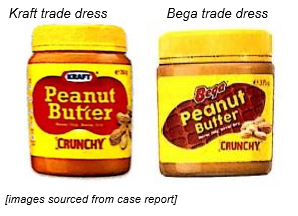Most of us won’t remember 2020 as a Michelin 3 star gourmet type of year. Many won’t even think of it as a good Sunday roast. Instead, I’m prepared to suggest that the majority of us will think of it as a take-away or burger at best.
Perhaps a fitting analogy when 2 of the “BIG” IP issues this year involved McDonald’s taking on Hungry Jack’s over their use of the name “Big Jack” and Bega’s success in preventing Kraft from continuing to use the peanut butter trade dress which they acquired as part of a $460M purchase in 2017.
Are Hungry Jack’s Hamburglers?
In the “battle of the burgers”, which is still being slugged out in the Federal Court, McDonald’s is alleging that Hungry Jack’s has infringed its Big Mac trade marks through the use of the similar mark “Big Jack”, launched in July of this year.
Interestingly, BIG JACK is a registered trade mark in Australia. The mark was unopposed following its filing in November 2019 and proceeded to registration in June 2020. The trade marks office didn’t consider McDonald’s existing BIG MAC trade mark to be similar and approved the application for registration. McDonald’s are now taking up that argument in the Federal Court.
However, based on preliminary hearings, it seems as though McDonald’s will have its work cut out in convincing the court that any “Australian consumer” would ever be confused “in the slightest”, which is the position according to Hungry Jack’s lawyers.
McDonald’s have also argued that the burgers look deceptively similar, again leading to the likelihood of confusion. In addition, they claim that the use of the similar tag line, which states that the burger contains “two flame-grilled 100% Aussie beef patties, topped with melted cheese, special sauce, fresh lettuce, pickles and onions on a toasted sesame seed bun”, will confuse consumers with McDonald’s well know tag line. So far the court has found unpalatable the suggestion that the tag lines or the appearance of the 2 products is similar and confusing/misleading. It noted that McDonald’s hasn’t sought to register trade marks in relation to the appearance of its burger, as it has with other items such as a figurine of the Ronald McDonald character, burglar and a box/carton shape mark.
The claims are all denied by Hungry Jack’s, which is no stranger to trade mark disputes in Australia, having had to choose an alternative name when it first came into the country. The chain which is more well known internationally as Burger King was unable to trade in Australia under that name due to another trader (in Burleigh Heads) having first used/registered the mark in Australia.
The case is a reminder to be vigilant about frequently reviewing your trade marks and making sure that all of your key marks are secured. It also serves as a reminder to monitor the market to see what your competitors are up to.
Peanut butter wars
Many of those points are also relevant to the dispute between Bega and Kraft, which we first reported on in late 2019.
This matter went on appeal to the Full Court of the Federal Court in 2020.
The core of the dispute was over what IP rights had been sold to Bega in 2017. In particular, the court had to consider which of the parties held the right, to use the distinctive trade dress or ‘get up’ which Kraft had been using for many years prior to the sale. Bega’s position, again accepted by the Court, was that Kraft’s use of the Peanut Butter Trade Dress was likely to mislead consumers, given that it had become the owner of the trade dress rights.
The trade dress was described as ‘a jar with yellow lid, yellow label, blue or red peanut device (logo) and having a brown appearance when filled’, which you would hope was the case with peanut butter. A comparison of the products is shown below.

Findings
The Full Court unanimously held that Bega had acquired rights to the Peanut Butter trade dress as part of the purchase. That was despite Kraft arguing that it had assigned all trademarks to its parent company or another entity in its group prior to completing the sale to Bega. However, the court held that the trade dress was an unregistered trademark and had not been assigned.
That was because it held to be uncontroversial that under Australian law, unregistered trade marks can only be assigned together with the goodwill of the business in which it has been used. That is consistent with the position in the US (under the Lanham Act), which prohibits assignments “in gross” – i.e. without the goodwill of the relevant business.
The decision confirmed that goodwill generated through use of an unregistered trade mark is not (a species of) property and instead, can only be protected by an action for passing off or breach of the Australian Consumer Law.
As goodwill is generated through use/reputation, the Full Court also sought to identify who owned the goodwill generated through use of the Peanut Butter trade dress. In short, the Court concluded that the goodwill was at all times held by Kraft (and not its parent company or another entity in its corporate group), before being acquired by Bega. That was because Kraft was the entity which had developed and used the trade dress. The fact that Kraft was owned by a parent company (which owned other registered trade marks) was irrelevant to its ownership of that goodwill.
On that basis, the goodwill remained with Kraft until its business was sold to Bega. It was not possible for that goodwill to be assigned by Kraft separately from its business.
Key takeaways
The Full Court’s approach will be of concern to trade mark licensors, as:
- Many businesses use trade marks which are not registered. Those are not always easy to identify and can exist (such as in this case) in the form of trade dress or get-up, labelling or packaging. However, unregistered marks can also include taglines, phrases, logos, brands or even trading names which haven’t been registered as trade marks.
- The decision highlights the need to register all commercially valuable unregistered marks (including taglines, logos, trading names, get-up, labelling or packaging which haven’t been registered as trade marks). Otherwise, those could end up being owned by a licensee who has used and generated goodwill in them.
- Businesses should be considering whether they hold unregistered trade marks (including in trade dress or getup), which could be secured through registration.
- Businesses should also be reviewing any licences they have entered into, including intergroup licences, which grant others the right to use trade marks (including unregistered marks). As it was previously common for both registered and unregistered trademarks to be licensed, many existing licences may now have unintended consequences and require review.
- Further, businesses which licence unregistered IP (which is not limited to, but common in franchising and even distribution) should be reviewing their arrangements.
- This applies equally to a broad range of organizations who allow others to use their marks, such as:
- Corporate groups which have subsidiaries or related entities
- Schools who have related entities, such as a P&F Association
- Clubs who have related entities
We trust that you won’t overindulge this festive season. Wishing you all a very Merry Christmas and all the best for the New Year, as we leap headlong towards 2021.
